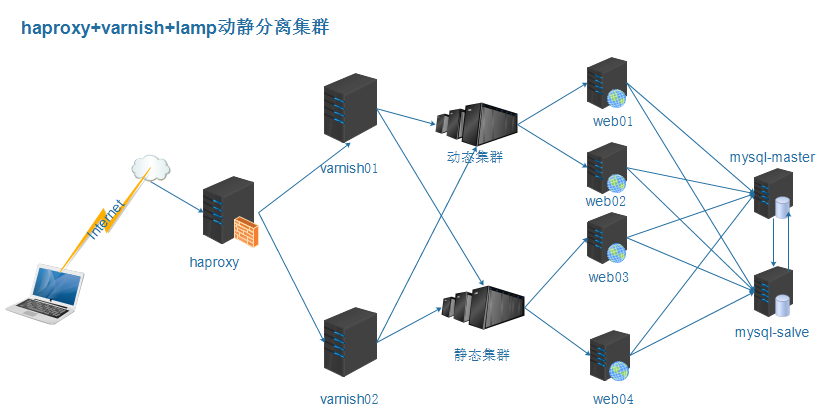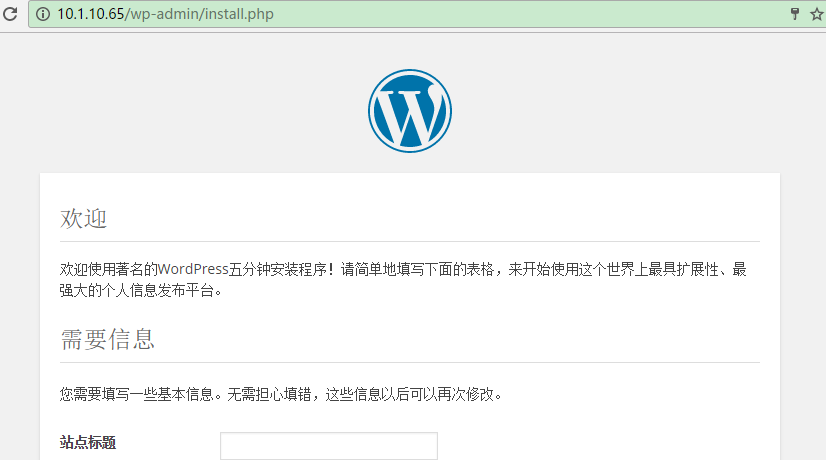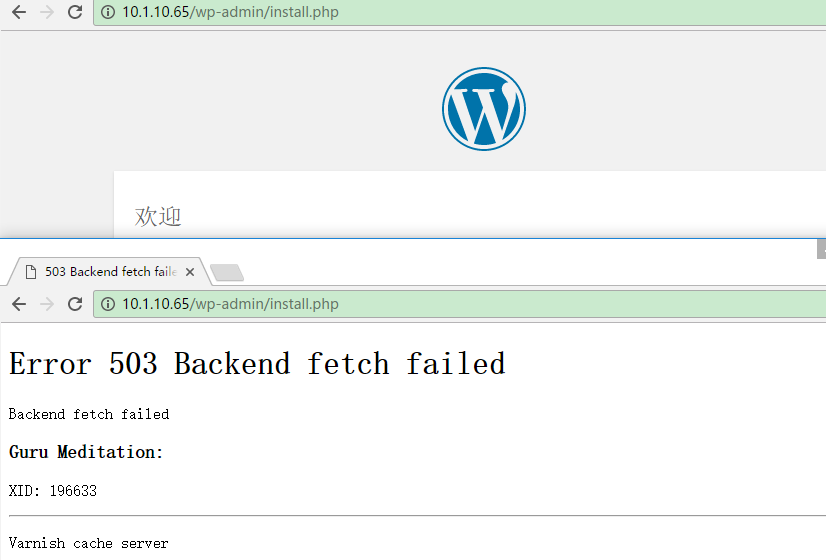一、简介
Haproxy一个高性能的负载均衡服务软件,它可基于四层和七层之间进行调度,而且对各个节点具有健康状态检测的功能,当后端服务器故障时,会自动标记为不可用状态,当服务器上线时还会自动将后端主机上线。比起lvs其配置简单,且引入了frontend,backend,listen等功能,frontend可添加acl规则,可根据HTTP请求头做规则匹配,然后把请求定向到相关的backend。
二、配置相关参数详解
haproxy主要分为global、defaults、front、backend、listen几段,配置文件详细说明如下:
|
1
2
3
4
5
6
7
8
9
10
11
12
13
14
15
16
17
18
19
20
21
22
23
24
25
26
27
28
29
30
31
32
33
34
35
36
37
38
39
40
41
42
43
44
45
46
47
48
49
50
51
52
53
54
55
56
57
58
59
60
61
62
63
64
65
66
67
68
69
70
71
72
73
74
75
76
77
78
79
80
81
82
83
84
85
86
87
88
89
90
91
92
93
94
95
96
97
98
99
|
#---------------------------------------------------------------------
# Global settings #全局配置段
#---------------------------------------------------------------------
global
#全局配置段
# to have these messages end up in /var/log/haproxy.log you will
# need to:
#
# 1) configure syslog to accept network log events. This is done
# by adding the '-r' option to the SYSLOGD_OPTIONS in
# /etc/sysconfig/syslog
#
# 2) configure local2 events to go to the /var/log/haproxy.log
# file. A line like the following can be added to
# /etc/sysconfig/syslog
#
# local2.* /var/log/haproxy.log #如需保存日志文件需修改/etc/rsyslog.cfg添加此项至配置问文件中重启rsyslog
#
log 127.0.0.1 local2
#日志将通过rsyslog进行记录
chroot
/var/lib/haproxy
#运行的安装路径
pidfile
/var/run/haproxy
.pid
#运行时的pid进程文件
maxconn 4000
#最大连接数
user haproxy
#运行以haproxy用户
group haproxy
#运行以haproxy用户
daemon
#以守护进程的方式运行haproxy
# turn on stats unix socket
stats socket
/var/lib/haproxy/stats
#---------------------------------------------------------------------
# common defaults that all the 'listen' and 'backend' sections will
# use if not designated in their block
#---------------------------------------------------------------------
defaults
mode http
#工作模式
log global
#记录日志级别为全局
option httplog
#详细的http日志
option dontlognull
option http-server-close
option forwardfor except 127.0.0.0
/8
#传递客服端IP
option redispatch
retries 3
#失败后重试次数
timeout http-request 10s
#http请求超时时长
timeout queue 1m
timeout connect 10s
timeout client 1m
timeout server 1m
timeout http-keep-alive 10s
timeout check 10s
#心跳信息检测超时时长
maxconn 3000
#---------------------------------------------------------------------
# main frontend which proxys to the backends
#---------------------------------------------------------------------
listen stats
mode http
bind *:1080
stats
enable
stats hide-version
stats uri
/admin
stats realm Haproxy\ Statistics
stats auth admin:admin
stats admin
if
TRUE
frontend main
bind *:80
#定义acl规则
acl url_static path_beg -i
/static
/images
/javascript
/stylesheets
#请求报文中以此类开头的都定义为uri_static
acl url_static path_end -i .jpg .gif .png .css .js .html .ico
#不区分大小写一此类.*结尾的都定义为url_static
acl url_dynamic path_end -i .php .jsp .asp
#不区分大小写以此类开头的定义为动态资源组
use_backend static
if
url_static
#调用后端服务器并检测规则
use_backend bynamic
if
url_dynamic
#调用后端服务器并检查规则
default_backend static
#使用默认规则
#---------------------------------------------------------------------
# static backend for serving up images, stylesheets and such
#---------------------------------------------------------------------
backend static
#后端调度
balance roundrobin
#调度算法,除此外还有static-rr,leaseconn,first,source,uri等
server static 192.168.10.125:80 inter 1500 rise 2 fall 3 check
rspadd X-Via:static
#启用响应报文首部标志,以便观察是静态服务器反馈的
#---------------------------------------------------------------------
# round robin balancing between the various backends
#---------------------------------------------------------------------
backend dynamic
balance
source
server s2 172.16.10.12:80 check inter 1500 rise 2 fall 3
#check inter 1500是检测心跳频率
#rise2 2次正确认为服务器可用
#fall3 3次失败认为服务器不可用
#---------------------------------------------------------------------
# round robin balancing listen option
#---------------------------------------------------------------------
listen statistics
mode http
#http 7 层模式
bind *:9988
#监听地址
stats
enable
#启用状态监控
stats auth admin:admin
#验证的用户与密码
stats uri
/admin
?stats
#访问路径
stats hide-version
#隐藏状态页面版本号
stats admin
if
TRUE
#如果验证通过了就允许登录
stats refresh 3s
#每3秒刷新一次
acl allow src 192.168.18.0
/24
#允许的访问的IP地址
tcp-request content accept
if
allow
#允许的地址段就允许访问
tcp-request content reject
#拒绝非法连接
|
三、haproxy+varnish实现动静分离小案例
实验架构拓扑图:
架构说明:用户请求到达前端,通过haproxy调度到varnish缓存服务器上,当缓存服务器上的资源命中且未过期时直接叫资源响应改用户,当未命中时通过在两台varnish服务器上设置匹配规则将其转发至后端响应的动态和静态服务器上,后端动态或静态服务器均使用nfs网络文件共享使用同一个资源目录,同时将使用同一台厚分离出来的mysql服务器作为存储数据使用,考虑单点故障的瓶颈,mysql服务器将使用主从两台实现高可用主负责读写均可,但从服务器为只读,同理路由需要也可在前端haproxy代理提供冗余。
实验环境如下:
前端:HAProxy
1、调度服务器:Varnish1、Varnish2
2、调度算法一致性URL哈希:URL_Hash_Consistent
3、集群统计页:ipaddr/haproxy?admin
缓存服务器:Varnish
1、VarnishServer01
2、VarnishServer02
3、开启健康状态探测,提供高可用
4、负载均衡后端Web服务器组
5、动静分离后端服务器,并动静都提供负载均衡效果
后端服务器:
StaticServer01
StaticServer02
DynamicServer01
DynamicServer02
Mysql服务器:
MysqlServer-master
MysqlServer-slave
haproxy配置如下:
|
1
2
3
4
5
6
7
8
9
10
11
12
13
14
15
16
17
18
19
20
21
22
23
24
25
26
27
28
29
30
31
32
33
34
35
36
37
38
39
40
41
42
43
44
45
46
47
48
49
50
51
52
53
54
55
56
57
58
59
60
61
62
63
64
65
66
67
68
69
|
#---------------------------------------------------------------------
# Global settings
#---------------------------------------------------------------------
global
# to have these messages end up in /var/log/haproxy.log you will
# need to:
#
# 1) configure syslog to accept network log events. This is done
# by adding the '-r' option to the SYSLOGD_OPTIONS in
# /etc/sysconfig/syslog
#
# 2) configure local2 events to go to the /var/log/haproxy.log
# file. A line like the following can be added to
# /etc/sysconfig/syslog
#
# local2.* /var/log/haproxy.log
#
log 127.0.0.1 local2
chroot
/var/lib/haproxy
pidfile
/var/run/haproxy
.pid
maxconn 4000
user haproxy
group haproxy
daemon
# turn on stats unix socket
stats socket
/var/lib/haproxy/stats
#---------------------------------------------------------------------
# common defaults that all the 'listen' and 'backend' sections will
# use if not designated in their block
#---------------------------------------------------------------------
defaults
mode http
log global
option httplog
option dontlognull
option http-server-close
option forwardfor except 127.0.0.0
/8
option redispatch
retries 3
timeout http-request 10s
timeout queue 1m
timeout connect 10s
timeout client 1m
timeout server 1m
timeout http-keep-alive 10s
timeout check 10s
maxconn 3000
#---------------------------------------------------------------------
# main frontend which proxys to the backends
#---------------------------------------------------------------------
frontend web *:80
#acl url_static path_beg-i /static /images /javascript /sytlesheets
#acl url_static path_end -i .jpg .gif .png .css .js
#use_backend staticif url_static
use_backendvarnish_srv
#---------------------------------------------------------------------
# vanrnish server balance method
#---------------------------------------------------------------------
backend varnish_srv
#定义varnish后端主机组
balance uri
#一致性hash
hash
-
type
consistent
#一致性hash url
servervarnish1 10.1.10.6:9988 check
#varnish服务器1,并添加健康状态检测
servervarnish2 10.1.10.7:9988 check
#varnish服务器02,并添加健康状态检测
listen stats
#定义状态监控管理页
bind:9002
stats uri
/alren
?admin
#页面URL
stats hide-version
#影藏版文本信息
stats authadmin:alren
#提供认证页面
stats admin
if
TRUE
#认证通过则条状到相应页面
|
varnish配置如下:
|
1
2
3
4
5
6
7
8
9
10
11
12
13
14
15
16
17
18
19
20
21
22
23
24
25
26
27
28
29
30
31
32
33
34
35
36
37
38
39
40
41
42
43
44
45
46
47
48
49
50
51
52
53
54
55
56
57
58
59
60
61
62
63
64
65
66
67
68
69
70
71
72
73
74
75
76
77
78
79
80
81
82
83
84
85
86
87
88
89
90
91
92
93
94
95
96
97
98
99
100
101
102
103
104
105
106
107
108
109
110
111
112
113
114
115
116
117
118
119
120
121
122
123
124
125
126
127
128
129
130
131
132
133
134
135
136
137
138
139
140
141
142
143
144
145
146
|
# This is an example VCL file for Varnish.
#
# It does not do anything by default, delegating control to the
# builtin VCL. The builtin VCL is called when there is no explicit
# return statement.
#
# See the VCL chapters in the Users Guide at https://www.varnish-cache.org/docs/
# and http://varnish-cache.org/trac/wiki/VCLExamples for more examples.
# Marker to tell the VCL compiler that this VCL has been adapted to the
# new 4.0 format.
vcl 4.0;
#版本信息
import
directors;
#导入模块
acl purges {
#定义修剪规则
"127.0.0.1"
;
"10.1.10.0"
;
}
backend web1 {
.host =
"10.1.10.68:80"
;
.port =
"80"
;
.url =
"/heath.php"
;
.timeout = 2s;
.interval = 1s;
.window = 6;
.threshold = 3;
.expected_response = 200;
.initial = 2;
}
backend web2 {
.host =
"10.1.10.69:80"
;
.port =
"80"
;
.url =
"/heath.php"
;
.timeout = 2s;
.interval = 1s;
.window = 6;
.threshold = 3;
.expected_response = 200;
.initial = 2;
}
backend app1 {
.host =
"10.1.10.70:80"
;
.port =
"80"
;
.url =
"/heath.html"
;
.timeout = 2s;
.interval = 1s;
.window = 6;
.threshold = 3;
.expected_response = 200;
.initial = 2;
}
backend app2 {
.host =
"10.1.10.71:80"
;
.port =
"80"
;
.url =
"/heath.html"
;
.timeout = 2s;
.interval = 1s;
.window = 6;
.threshold = 3;
.expected_response = 200;
.initial = 2;
}
sub vcl_init {
new webcluster = directors.round_robin();
webcluster.add_backend(web1);
webcluster.add_backend(web2);
new appcluster = directors.round_robin();
appcluster.add_backend(app1);
appcluster.add_backend(app2);
}
sub vcl_recv {
if
(req.method ==
"PURGE"
){
if
(!client.ip ~ purges){
return
(synth(408,
"you don't have permission purge "
+ client.ip));
}
return
(purge);
}
if
(req.url ~
"(?i)\.(php|asp|aspx|jsp)($|\?)"
) {
set
req.backend_hint = appcluster.backend();
}
if
(req.method !=
"GET"
&&
req.method !=
"HEAD"
&&
req.method !=
"PUT"
&&
req.method !=
"POST"
&&
req.method !=
"TRACE"
&&
req.method !=
"OPTIONS"
&&
req.method !=
"PATCH"
&&
req.method !=
"DELETE"
) {
return
(pipe);
}
if
(req.method !=
"GET"
&& req.method !=
"HEAD"
) {
return
(pass);
}
if
(req.http.Authorization || req.http.Cookie) {
return
(pass);
}
if
(req.http.Accept-Encoding) {
if
(req.url ~
"\.(bmp|png|gif|jpg|jpeg|ico|gz|tgz|bz2|tbz|zip|rar|mp3|mp4|ogg|swf|flv)$"
) {
unset
req.http.Accept-Encoding;
} elseif (req.http.Accept-Encoding ~
"gzip"
) {
set
req.http.Accept-Encoding =
"gzip"
;
} elseif (req.http.Accept-Encoding ~
"deflate"
) {
set
req.http.Accept-Encoding =
"deflate"
;
}
else
{
unset
req.http.Accept-Encoding;
}
}
return
(
hash
);
}
sub vcl_pipe {
return
(pipe);
}
sub vcl_miss {
return
(fetch);
}
sub vcl_hash {
hash_data(req.url);
if
(req.http.host) {
hash_data(req.http.host);
}
else
{
hash_data(server.ip);
}
if
(req.http.Accept-Encoding ~
"gzip"
) {
hash_data (
"gzip"
);
} elseif (req.http.Accept-Encoding ~
"deflate"
) {
hash_data (
"deflate"
);
}
}
sub vcl_backend_response {
if
(beresp.http.cache-control !~
"s-maxage"
) {
if
(bereq.url ~
"(?i)\.(jpg|jpeg|png|gif|css|js|html|htm)$"
) {
unset
beresp.http.Set-Cookie;
set
beresp.ttl = 3600s;
}
}
}
sub vcl_purge {
return
(synth(200,
"Purged"
));
}
sub vcl_deliver {
if
(obj.hits > 0) {
set
resp.http.X-Cache =
"HIT via "
+ req.http.host;
set
resp.http.X-Cache-Hits = obj.hits;
}
else
{
set
resp.http.X-Cache =
"MISS via "
+ req.http.host;
}
}
|
上诉完成后,配置web服务,使用nfs网络文件系统并且提供实时数据同步(rsync+inotify),启动mysql进行授权用户和创建数据库,搭建WordPress或其他应用程序,此过程简单就不啰嗦,此架构存在一定的不足之处,即单点故障会导致用户请求失败。
实现效果如下所示:
将nfs服务端停止后实验图:
本文转自chengong1013 51CTO博客,原文链接:http://blog.51cto.com/purify/1872279,如需转载请自行联系原作者






